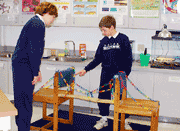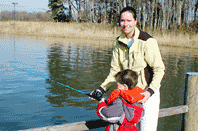 |
|||||||||||
|
|||||||||||
|
|||||||||||
Where I’ve Been; Where They’re GoingThe natural education of a new generationNature’s simple secrets can hide in quiet pools, and life’s greatest lessons are not all learned in schools.—UnknownThe simplest of nature’s secrets are concealed in the quiet pools underneath our very noses, awaiting to be discovered by each succeeding generation. We refer to the process as Life: learning by experience, what we document in our minds through observation, feeling, hearing and yes, even smelling, as when waters turn sour. From the beginning, we grasp new basics via everyday trial and error. Then come schools with their more formal ways of teaching and learning. Facts, facts and more facts. So much to learn, so little time. From the perspective of this writer, born when Calvin Coolidge was our 30th president, in these troubled times we discover there is so much more to learn and so little time to learn it that we increasingly speculate whether we are up to the task. The Big TestConsider that more than a few of our earth’s more learned within the scientific community warn us that within 40 years we could first endure the real tangible impact of global warming. Not just melting ice caps and rising sea levels but also famine, disease, more hostile wind-generated storms, flooding and climbing temperatures. Also, what happens when seas become inhospitable for marine life and now-dry lands that support agriculture are flooded and no longer tillable? How will a selfish society react? Can it really boil down to survival of the fittest? Some mighty big questions, indeed. No longer can we defer the moment of truth as a reckoning thousands or even millions of years hence. Natural evolution, thanks to our wanton disregard, no longer rules. We’re now talking about as soon as 2047. Many will tell us that warming and cooling cycles of earth have gone on since the very beginning -— and will continue to do so until the end. So why get ourselves all worked up? To them I can only say, true to a point. But the overwhelming evidence of the past 25 to 50 years is that while natural change has been taking place on its own, we’re hastening things more than appreciably by our environmental follies. Nothing we can do about nature’s own cycle, but much can be done about what we are doing to hasten the inevitable.
Old Lesson; New KidsOn April 22, 1970, we observed our first Earth Day, an occasion since set aside to remind us how precious is our earth — and how lacking we are in its stewardship. Now, 37 Earth Days later, little has changed. The occasion remains a footnote on the calendar, earth remains in deep doo-doo — and we’re not doing much to enhance our stewardship. In mid-April, I decided it appropriate to check in on Earth Day, you might say to learn what we have learned from the previous 36, if anything. Is the observance of the day really relevant? What better research than to tag along with the 75 students, pre-kindergarten through fifth grade of Gibson Island Country School in Pasadena, where the observance was stretched into a week of environmental awareness and activities. Classroom learning and learning through experience, a perfect mix. But in midweek my old ticker kicked up. Nearly four weeks later and after a few ambulance rides, two stents in arteries and a new defribrillator implanted next to the heart, my notes seemed old, too old for fresh news. Yet there was an encouraging story to tell of the process of living and learning in a new generation. School staffer Courtney Leith put the Bay Week program together for the third year; what I witnessed sitting among the students was not a bit of the Bay and environment mixed in with the general curriculum; no it was the other way around. Earth Day ruled for five days. The curriculum gave us leave to enjoy our surroundings sufficiently that a lifelong interest in preserving and/or improving what we have would be seeded within us. If done right, is this not worth a full week of formal school? If you know the answer it’s not a question. For pre-K’er James Doss, the lack of white perch on the hook was more than made up for by the sight of an osprey fishing the same waters from its nest nearby. The broken shells on the dock dropped by other birds to break them open was a reminder that we’re not the only ones who eat lunch. The hard oyster bottom was a reminder that clean waters mean more than bathing. Geoff Kolberg of the State Highway Administration talked on the Bay Bridge and what bridges can mean in the transportation system, the good and the bad from fishing to development and a means from getting here to there. Brewer Butler was fascinated; he and his dad David fish there often. His class put together a model bridge in the classroom. Other themes covered the history and culture of Maryland rivers, butterfly gardens, terrapins and turtles, birdlife on wooded shorelines. tours, nature trails, even milkweed plants. Old stuff to oldies, but a new generation was absorbing the intricate relationship between humankind and our surroundings in a lesson designed to last a lifetime. Is Earth Day worth observing? Judging by the enthusiasm and just plain joy of my young fellow students, that week the answer was a resounding yes. Before we know it, this new generation will be taking over. If we foster their quest for more appreciation, interest and knowledge, we have set them on the right track in life. Enough said. |
|||||||||||
|
|||||||||||
|
|
|||||||||||
|
© COPYRIGHT 2007 by New Bay Enterprises, Inc. All rights reserved.
|
|||||||||||


